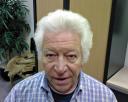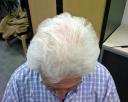25.01.2008
in HAIR LOSS SCIENCE
Side line the side effects.

Side effects are constant companions of chemotherapy since the day of its discovery. Though modern research has managed to curb side effects to some extent, moments of worries are still there. Sachin Jagdale explores the issue
Imagine being cured of cancer only to discover that you have become permanently infertile. Or you have conquered cancer at the cost of your kidneys and you will require dialysis throughout life. What will life be if the cost of curing cancer is getting a permanent hearing impairment? These are rare side effects of chemotherapy, but are extremely disturbing.
Chemotherapy is an effective option to treat cancer because it interferes with rapidly dividing cells. However, the agony is that chemotherapy cannot distinguish between the ‘good guys’ (normal cells) and the ‘bad guys’ (the cancer cells), both of which are rapidly dividing cells. Thus ever since the use of the first chemotherapy agents like nitrogen mustards and folic acid antagonist drugs in the 1940s, chemotherapy has extracted a heavy price. In fact oncologists have to accept this bitter fact and admit that some times the side effects of chemotherapy kill the patient than the cancer does. “It may be an immediate anaphylactic reaction or neutropenic related severe infection,” says Dr Ganapathi Bhat, Honorary consultant, Medical Oncologist and Stem Cell Physician, Jaslok Hospital and Research Center, Mumbai.
Dr Ganapathi Bhat
Honorary Consultant, Medical Oncologist and Stem Cell Physician
Jaslok Hospital and Research Center, Mumbai
There are various guidelines to be followed while using chemotherapy. Bhat says, “Cytotoxic agents should not be prescribed by physicians inexperienced in their use. Dosages are modified according to the curability of the tumour and established guidelines for each drug or regimen. Chemotherapy is generally postponed if the patient has an infection of any type, persistent toxicity from previous treatments, or significant debility from cancer (Karnofsky’s scale performance status less than 50 percent).”
Dr Avinash Deo
Medical Oncologist-Hemato oncologist, Asian Institute of Oncology
S L Raheja Hospital, Mumbai
The seriousness of the side effects has led to the practice of oncologists preferring to have extensive counseling sessions with the patients and their families before the start of the treatment, to make them aware of and prepare them for the possible side effects of chemotherapy. Since chemotherapy remains the most trusted way of treating cancer, patients hardly see any other alternative to deal with the disease. Dr Avinash Deo, Medical oncologist-Hemato oncologist, Asian Institute of Oncology, S L Raheja Hospital, Mumbai, echoes Bhat’s opinion on the side effects of chemotherapy. Deo opines, “Chemotherapy is the only proven therapy for cancer that has spread. Unfortunately chemotherapy has life threatening adverse effects. Chemotherapy and antibiotics kill by exploiting differences between the offending cell (bacteria or cancer cell) and the human cell. The cancer cell is a human cell and a few normal cells do get killed resulting in side effects.”
Unified efforts
Deo also offers a ray of hope, saying that almost all side effects of chemotherapy are reversible. What is more heartening is the possibility that an expert oncologist may even be able to minimises the side effects of chemotherapy by appropriate scheduling of chemotherapy sessions.
Ultimately, it requires the unified efforts of both doctor and pharma companies to alleviate the woes of cancer patients. The skill of doctors is to treat patients with minimal damage to his body while it is the duty of pharma companies to try their best to make drugs with less possible toxicity. Deo says, “Attempts to overcome toxicity of therapy fall into two general categories. The first is development of drugs that can counter adverse effects. Examples of this are drugs to counter nausea and vomiting (Ondansetron, Granisetron, Palonosetron, Aprepitant) and decreased blood formation (filgrastim, erythropoietin). The other approach is to develop drugs free of toxicity.”
There are many national and international pharma companies that produce chemotherapeutic drugs. There are many critics as well who criticise pharma companies for producing toxic drugs. A sample quote posted on the web by an eminent European oncologist Dr Glen Warner reveals the intensity of the debate on this subject; “We have a multi-billion dollar industry that is killing people, right and left, just for financial gain. Their idea of research is to see whether two doses of this poison is better than three doses of that poison.”
However, despite all negative criticism, companies like Glenmark Pharmaceuticals are genuinely focusing efforts to minimise toxicity of their chemotherapy drugs. Dr Akhilesh Sharma, MD (Bom), Vice President-Medical Services, Glenmark, says, “Globally a lot of research work has been directed towards the development of newer, safer and targeted therapies for better efficacy and safety profile. Research work at Glenmark is directed towards development of more targeted therapies for the reduction of toxicity by chemotherapeutic drugs.” He adds, “NK1 receptor antagonists are effective against delayed chemotherapy induced nausea and vomiting (CINV) besides having a role in acute CINV. Glenmark was the first to introduce Aprepitant (brand name Aprecap) a novel NK1 receptor antagonist in India.”
There are many chemotherapeutic drugs that have major side effects on patients. However, all side effects never come with a single drug. Each drug has its specific side effects. “For chemotherapy and other cancer drugs, there’s often a small window between active and toxic. Secondly each chemotherapic drug has differed in their adverse effects (hematological toxicity, nausea, vomiting, hair loss and certain organ damage). For example hydroxyurea, methotrexate will cause cytopenia, vomiting but not hair loss, where as anthracyclines, taxanes will cause cytopenia as well as hair loss,” informs Bhat.
‘Targeting’ side effects
Considering the hazards of chemotherapy, methods for long-term treatment, with minimal side effects continue to be investigated. Targeted therapy is one such approach that has evolved in the second half of the 20th century. Most targeted cancer therapies are in preclinical testing (research with animals), but some are in clinical trials.
“The anti-cancer drugs of the future will be far more effective with minimal adverse effects. The first of such drugs, imatinib, has results in a 95 percent cure of chronic myeloid leukaemia with none of the adverse effects one expects with chemotherapy. The number of these drugs is growing astronomically,” cites Deo. Sharma says, “Our recent focus is targeted therapy to improve quality of life in cancer patients. Gefitinib, an EGFR (epidermal growth factor receptor) based targeted therapy has been recently launched by ONKOS (a division of Glenmark dedicated to oncology), which is effective against non-small cell lung carcinoma.”
Awareness is the key
Making the patient aware of the nature and likelihood of side effects will definitely improve adherence and patient satisfaction. It will also enhance a trusting relationship with the healthcare provider. Though the doctor is the prime source of the information for the patient, even the doctor needs to learn about medicines from pharma companies as they are the product providers.
So at the end of the day the pharma company can and should play an important role in educating patients and doctors about the drawbacks of its products,. Glenmark has already taken steps towards this. Sharma informs, “As a company, it is a continuous endeavour of Glenmark to create total awareness about any drug we market, amongst the doctors. Clinical studies in the Indian population, an active pharmacovigilance program help us identify rare adverse events at times. In all forms of our communications, along with the efficacy and benefits, we also highlight safety parameters like the adverse effect profile, precautions to be taken and contraindications to be followed.”
Glenmark’s interaction is not confined to doctors only, as ultimately patients are the consumers of their medicines. Considering the importance of patient education about the possible effects of medicines, Glenmark has taken some initiatives. Giving more details on these plans, Sharma says, “At the patient’s level we intend to have maximum participation from the patient in various patient education programs. We conduct patient meetings in coordination with the consulting doctor to create awareness about possible adverse effects and ways to ameliorate symptoms. We also distribute patient education material in regional languages to increase awareness levels amongst patients. Any adverse event reported by a patient or physician is registered into pharmacovigilance registers and we constantly update physicians and patients with the latest literature available.”
Hope is the best medicine
Chemotherapeutic drugs deliver more than you bargain for. Though chemotherapy and side effects have always gone hand in hand, this scenario is set to change soon. The human angle and desperate efforts from researchers to minimise chemotherapy-induced miseries on cancer patients have resulted in discoveries of treatments like targeted therapy. We must accept finite disappointment, but never lose infinite hope. Let hope modern discoveries like targeted therapy will succeed in side lining the side effects.
Do you have Hair Loss Problems, read our Hair Loss Help
Link: http://www.expresspharmaonline.com/20080131/research01.shtml











